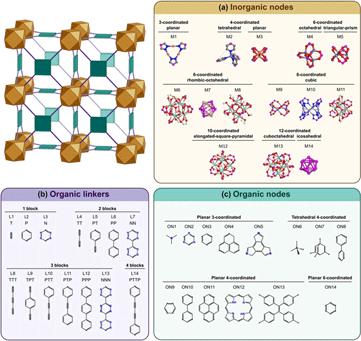当前位置:
X-MOL 学术
›
J. Mater. Res.
›
论文详情
Our official English website, www.x-mol.net, welcomes your
feedback! (Note: you will need to create a separate account there.)
Recent trends on density functional theory–assisted calculations of structures and properties of metal–organic frameworks and metal–organic frameworks-derived nanocarbons
Journal of Materials Research ( IF 2.7 ) Pub Date : 2020-06-08 , DOI: 10.1557/jmr.2020.109 Oxana V. Kharissova , Boris I. Kharisov , Lucy T. González
Journal of Materials Research ( IF 2.7 ) Pub Date : 2020-06-08 , DOI: 10.1557/jmr.2020.109 Oxana V. Kharissova , Boris I. Kharisov , Lucy T. González

|
Metal–organic frameworks (MOFs) possess tuneable properties and a variety of important applications in the areas of catalysis, adsorption, gas storage, and separation, among others. Herein, recent computational studies by density functional theory (DFT) applied for simulations of MOF structure and complex architecture determination, prediction of properties, and computational characterization, including large-scale screening and geometrical properties of hypothetical MOFs, diffusion and adsorption processes in MOFs, are reviewed. DFT calculations have been applied in the MOF area to study chemical stability; mechanical, photophysical, optical, and magnetic properties; photoluminescence; porosity; and semiconductor or metallic character. The prediction of MOF analogs with open-metal sites, studies of chemical bonding and the prediction of energies by quantum mechanics allows reducing experimental efforts in the creation of MOF/polymer membranes, adsorbents for CO2 uptake, separation of C2H2/CH4, C2H2/CO2, and inert gases, radionuclides sequestration, and water adsorption, as well as other promising advances. For the MOF-derived carbons, a lack of profound DFT investigations is currently observed, being mainly restricted to the electrocatalysis area (nitrogen reduction reaction, oxygen evolution reaction, and hydrogen evolution reaction), resulting applications in batteries and other storage devices, CO2 sequestration, and absorbance of organic substances.
中文翻译:

密度泛函理论辅助计算金属-有机骨架和金属-有机骨架衍生的纳米碳的结构和性能的最新趋势
金属有机骨架(MOF)具有可调节的特性,在催化、吸附、气体储存和分离等领域具有多种重要应用。在此,最近密度泛函理论 (DFT) 的计算研究应用于 MOF 结构和复杂结构确定的模拟、性质预测和计算表征,包括假设 MOF 的大规模筛选和几何性质、MOF 中的扩散和吸附过程,被审查。DFT计算已应用于MOF领域研究化学稳定性;机械、光物理、光学和磁性能;光致发光;孔隙率;和半导体或金属特性。具有开放金属位点的 MOF 类似物的预测,通过量子力学研究化学键和能量预测可以减少在创建 MOF/聚合物膜、吸收 CO2 的吸附剂、分离 C2H2/CH4、C2H2/CO2 和惰性气体、放射性核素封存和水吸附方面的实验工作,以及其他有希望的进展。对于 MOF 衍生的碳,目前缺乏深入的 DFT 研究,主要局限于电催化领域(氮还原反应、析氧反应和析氢反应),导致在电池和其他存储设备中的应用,CO2 封存, 和有机物的吸光度。放射性核素封存和水吸附,以及其他有希望的进展。对于 MOF 衍生的碳,目前缺乏深入的 DFT 研究,主要局限于电催化领域(氮还原反应、析氧反应和析氢反应),导致在电池和其他存储设备中的应用,CO2 封存, 和有机物的吸光度。放射性核素封存和水吸附,以及其他有希望的进展。对于 MOF 衍生的碳,目前缺乏深入的 DFT 研究,主要局限于电催化领域(氮还原反应、析氧反应和析氢反应),导致在电池和其他存储设备中的应用,CO2 封存, 和有机物的吸光度。
更新日期:2020-06-08
中文翻译:

密度泛函理论辅助计算金属-有机骨架和金属-有机骨架衍生的纳米碳的结构和性能的最新趋势
金属有机骨架(MOF)具有可调节的特性,在催化、吸附、气体储存和分离等领域具有多种重要应用。在此,最近密度泛函理论 (DFT) 的计算研究应用于 MOF 结构和复杂结构确定的模拟、性质预测和计算表征,包括假设 MOF 的大规模筛选和几何性质、MOF 中的扩散和吸附过程,被审查。DFT计算已应用于MOF领域研究化学稳定性;机械、光物理、光学和磁性能;光致发光;孔隙率;和半导体或金属特性。具有开放金属位点的 MOF 类似物的预测,通过量子力学研究化学键和能量预测可以减少在创建 MOF/聚合物膜、吸收 CO2 的吸附剂、分离 C2H2/CH4、C2H2/CO2 和惰性气体、放射性核素封存和水吸附方面的实验工作,以及其他有希望的进展。对于 MOF 衍生的碳,目前缺乏深入的 DFT 研究,主要局限于电催化领域(氮还原反应、析氧反应和析氢反应),导致在电池和其他存储设备中的应用,CO2 封存, 和有机物的吸光度。放射性核素封存和水吸附,以及其他有希望的进展。对于 MOF 衍生的碳,目前缺乏深入的 DFT 研究,主要局限于电催化领域(氮还原反应、析氧反应和析氢反应),导致在电池和其他存储设备中的应用,CO2 封存, 和有机物的吸光度。放射性核素封存和水吸附,以及其他有希望的进展。对于 MOF 衍生的碳,目前缺乏深入的 DFT 研究,主要局限于电催化领域(氮还原反应、析氧反应和析氢反应),导致在电池和其他存储设备中的应用,CO2 封存, 和有机物的吸光度。











































 京公网安备 11010802027423号
京公网安备 11010802027423号